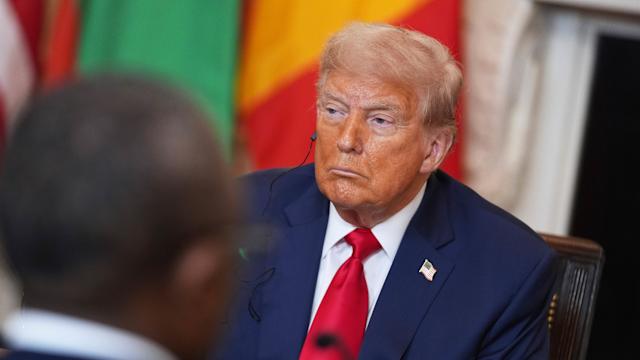Opinion: Trump’s Brazil tariff brings a new warning for investors

President Trump says his tariffs on imports are supposed to benefit the US economy. But he’s now threatening tariffs that have nothing to do with the economy and instead seem intended purely to benefit a political ally.
Trump on July 9 threatened a new 40% tariff on imports from Brazil — on top of a 10% baseline tariff he has already imposed on most imports, from everywhere — unless Brazil ends a prosecution of former president Jair Bolsonaro for trying to overturn the nation’s 2022 election.
Most of Trump’s tariffs are targeted at countries that have trade surpluses with the United States, which means we buy more of their stuff than they buy of ours. Trump’s stated purpose is to get those countries to buy more American exports or relocate production to the United States.
Brazil is different. It has a trade deficit with the United States, which means Brazil buys more American stuff than the other way around. This is exactly the type of trade relationship Trump wants to see everywhere. He regularly rails against the large US deficit with the rest of the world and says tariffs are necessary to rectify that.
In a July 9 letter Trump sent to the current Brazilian president, Luiz Inácio Lula da Silva, Trump started by saying that the prosecution of Bolsonaro is a “witch hunt that should end immediately.” Later on, he said that Brazil has a “very unfair trade relationship” with the United States and that the 50% tariff was necessary to “level the playing field.”
Read more: The latest news and updates on Trump's tariffs
Like most countries, Brazil does have some trade barriers meant to bolster domestic industries. Its tariff rate on US imports is a couple of percentage points higher than the (pre-Trump) US tariff rate on Brazilian imports. A recent report by the US Trade Representative put Brazil on a “watch list” for intellectual property theft, along with Canada, Mexico, and 18 other countries. But that’s not as severe as the “priority watch list,” which includes China, Russia, India, and Venezuela.
If Trump’s import tax does go into effect on Aug. 1, as he has threatened, it would be the United States that enjoys a “very unfair trade relationship” with Brazil, almost according to Trump’s own definition. The United States would have a trade deficit with Brazil while imposing sky-high tariffs, the ultimate barrier to trade.
Total US exports of goods and services to Brazil in 2024 were valued at $93.4 billion. Imports from Brazil were $60.9 billion. That’s a $33 billion trade surplus. Trump typically ignores trade in services and focuses only on goods. But the United States has a trade surplus in goods with Brazil, as well. Goods exports were $48.8 billion in 2024, while imports were $42.5 billion, for a modest $6.3 billion surplus.
Story ContinuesBrazil sells the United States industrial equipment, energy, aircraft, and of course coffee. The United States sells Brazil energy, chemical products, and machinery. Brazil represents 2.6% of US exports but only 1.2% of US imports. If every US trade relationship were like that, Trump’s complaints about a trade deficit would be moot.
Drop Rick Newman a note, take his weekly economy quiz, or sign up for his newsletter.
Brazilian president Lula says his country won’t yield to Trump’s demands on Bolsonaro, whose right-wing populism earned him the nickname “Trump of the Tropics” when he was Brazil’s president from 2019 to 2023. Bolsonaro lost a reelection bid in 2022 and, like Trump in 2020, blamed his loss on election fraud. A 2024 investigation alleged that Bolsonaro had attempted a “coup” aimed at preventing Lula from taking office. That prosecution is underway now.
Lula has threatened retaliatory tariffs on American imports if Trump imposes his own tariffs. In his July 9 letter, Trump said that any new tariff on US imports would be added to the Trump tariff on Brazilian imports. So if Brazil put a 20% tariff on US imports, the total Trump tariff on Brazilian imports would jump to 70%.
All of this gives Brazil the dubious distinction of facing the worst trade punishment Trump is currently threatening of any country. Trump imposed higher "reciprocal" tariffs on many nations on April 2, but he paused those after a week to reverse a drastic sell-off in financial markets. Trump now says reciprocal tariffs, generally lower than the April 2 rates, will go into effect on Aug. 1. All of the nations Trump is targeting with higher tariffs — except Brazil — have a trade surplus with the United States.
The current Trump tariff on Chinese imports is 30%. His threatened Aug. 1 tariffs are 36% for Thailand and Cambodia, 35% for Serbia and Bangladesh, 32% for Indonesia, and slightly less for other countries. Brazil would stand alone at 50% or higher.
Read more: What Trump's tariffs mean for the economy and your wallet
Since Brazil is a relatively small US trading partner, and vice versa, a side skirmish over the Bolsonaro issue wouldn’t mean a major escalation in Trump’s overall trade war. But it does mark a kind of mission creep for Trump’s tariff strategy, given that his chief motivation is personal and political, rather than economic.
“Trump’s threat of 50% tariffs on Brazil marked a significant change in his use of tariffs as a policy weapon because they aimed at shaping a domestic policy issue in a target country,” analyst Byron Callan of Capital Alpha Partners wrote in a July 10 research note. “We can’t recall when higher tariffs have been threatened if a domestic policy doesn’t change. If Brazil is a precedent, then it’s likely that Trump uses this threat against other countries whose domestic politics and policies don’t align with his own beliefs. Poland, South Korea, and France come to mind.”
In that regard, Trump’s Brazil tariff may serve as a warning to investors that new tariff threats are always on the table. Trump’s efforts to finalize trade deals with 15 or so target countries carry the connotation that there is some end state at which Trump’s tariffs will have served their purpose and be over and done with.
But maybe not.
Trump obviously views tariffs as a solution to many problems, in part because the US president can impose them at will in a wide range of cases. He began by using tariffs to achieve economic outcomes. But he’s testing whether they can serve even broader purposes. Trump’s tariff regime may only be getting started.
Rick Newman is a senior columnist for Yahoo Finance. Follow him on Bluesky and X: @rickjnewman.
Click here for political news related to business and money policies that will shape tomorrow's stock prices.
Read the latest financial and business news from Yahoo Finance



![Freeze-Dried Food Market Report: Share, Growth, and Forecast Analysis [Value: USD 2.75 Billion, CAGR: 9.6%]](http://weiss-technologies.com/zb_users/upload/2025/07/20250713021058175234385878077.jpg)










